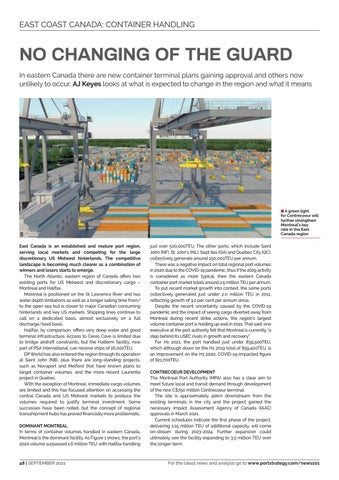EAST COAST CANADA: CONTAINER HANDLING
NO CHANGING OF THE GUARD In eastern Canada there are new container terminal plans gaining approval and others now unlikely to occur. AJ Keyes looks at what is expected to change in the region and what it means
8 A green light for Contrecoeur will further strengthen Montreal’s key role in the East Canada region
East Canada is an established and mature port region, serving local markets and competing for the large discretionary US Midwest hinterlands. The competitive landscape is becoming much clearer as a combination of winners and losers starts to emerge. The North Atlantic, eastern region of Canada offers two existing ports for US Midwest and discretionary cargo – Montreal and Halifax. Montreal is positioned on the St Lawrence River and has water depth limitations as well as a longer sailing time from/ to the open sea but is closer to major Canadian consuming hinterlands and key US markets. Shipping lines continue to call on a dedicated basis, almost exclusively on a full discharge/load basis. Halifax, by comparison, offers very deep water and good terminal infrastructure. Access to Ceres Cove is limited due to bridge airdraft constraints, but the Halterm facility, now part of PSA International, can receive ships of 16,000TEU. DP World has also entered the region through its operation at Saint John (NB), plus there are long-standing projects, such as Novaport and Melford that have known plans to target container volumes, and the more recent Laurentia project in Quebec. With the exception of Montreal, immediate cargo volumes are limited and this has focused attention on accessing the central Canada and US Midwest markets to produce the volumes required to justify terminal investment. Some successes have been noted, but the concept of regional transshipment hubs has proved financially more problematic. DOMINANT MONTREAL In terms of container volumes handled in eastern Canada, Montreal is the dominant facility. As Figure 1 shows, the port’s 2020 volume surpassed 1.6 million TEU, with Halifax handling
48 | SEPTEMBER 2021
just over 500,000TEU. The other ports, which include Saint John (NF), St. John’s (NL), Sept Iles (QA) and Quebec City (QC), collectively generate around 250,000TEU per annum. There was a negative impact on total regional port volumes in 2020 due to the COVID-19 pandemic, thus if the 2019 activity is considered as more typical, then the eastern Canada container port market totals around 2.5 million TEU per annum. To put recent market growth into context, the same ports collectively generated just under 2.0 million TEU in 2011, reflecting growth of 3.2 per cent per annum since. Despite the recent uncertainty caused by the COVID-19 pandemic and the impact of seeing cargo diverted away from Montreal during recent strike actions, the region’s largest volume container port is holding up well in 2021. That said, one executive at the port authority felt that Montreal is currently “a step behind its USEC rivals in growth and recovery”. For H1 2021, the port handled just under 839,500TEU, which although down on the H1 2019 total of 859,400TEU, is an improvement on the H1 2020, COVID-19-impacted figure of 821,700TEU. CONTRECOEUR DEVELOPMENT The Montreal Port Authority (MPA) also has a clear aim to meet future local and transit demand through development of the new C$750 million Contrecoeur terminal. The site is approximately 40km downstream from the existing terminals in the city and the project gained the necessary Impact Assessment Agency of Canada (IAAC) approvals in March 2021. Current schedules indicate the first phase of the project, delivering 1.15 million TEU of additional capacity, will come on-stream during 2023-2024. Further expansion could ultimately see the facility expanding to 3.5 million TEU over the longer-term.
For the latest news and analysis go to www.portstrategy.com/news101














